The Suitcase
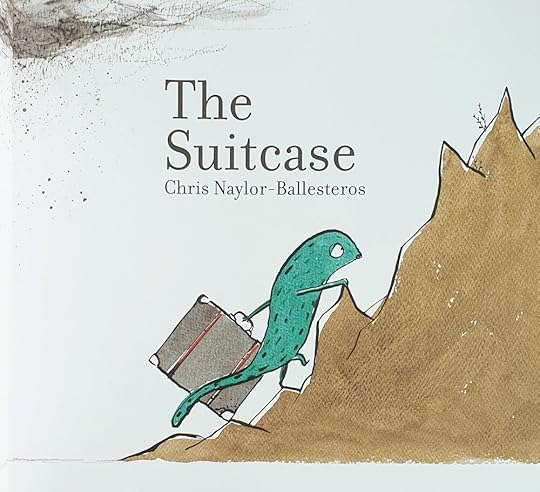
The Suitcase by Chris Naylor-Ballesteros (Nosy Crow, 2019) | © 2019 by Chris Naylor-Ballesteros
For I was hungry, and you gave Me something to eat; I was thirsty, and you gave Me something to drink; I was a stranger, and you invited Me in
— Jesus
Plenty of scientific research shows that reading fiction builds empathy.
By identifying with book characters, we learn to see things from another’s point of view; to step into someone else’s shoes.
People want to be seen.
They want to be heard - and understood.
It was the driving force behind the civil rights movement - and now the Black Lives Matters movement. It’s why victim-offender reconciliation programmes meet with success. It is the essence of empathy.
We can train even our youngest kids in kindness and empathy, through well-chosen picture books like The Suitcase by Chris Naylor-Ballesteros (Nosy Crow 2019). A ‘thought-provoking story about displacement and acceptance, The Suitcase is visually exciting and cleverly designed, and has been longlisted for the CILIP Kate Greenaway medal 2020.
The main character - a weary and lizard-like creature - is intriguing. He is hard to define - which serves to emphasise the fact that he is different. An outsider. The stranger who arrives under a dark cloud, dragging behind him an enormous suitcase. ‘Looking dusty, tired, sad and frightened,’ he is out of place - and piques everyone’s curiosity.
What a strange animal! I’ve never seen anything like him before.

The Suitcase by Chris Naylor-Ballesteros (Nosy Crow, 2019) | © 2019 by Chris Naylor-Ballesteros
In contrast, the other three players are easily identifiable as a fox, bird and rabbit. The characterisation is excellent! Naylor-Ballesteros has used ink with a dip pen to create the outlines (giving them a wonderfully variable appearance). Just look at their eyes and body language - the art speaks volumes.
The rabbit seems wary, wide-eyed.
The bird looks nervous (yet friendly) and is the first to greet the stranger: “Hey! Hi there!”
Unlike the fox, who appears somewhat irritated and suspicious - inconvenienced even. I think there’s a fair bit of fox in us all.
The dialogue sits in blocks above each character, in colours that correspond with that of the animal speaking. It’s a smart way of denoting who is speaking without any extraneous words (or the need for speech bubbles).
Another creative device is the way Naylor-Ballesteros’ uses soft, brown tones when the stranger describes the life he’s left behind. Like old, sepia-tinted photographs, they indicate memories - and give us a glimpse into his past:
… there’s a little kitchen in a wooden cabin where I make my tea. That’s my home.
It’s on a hillside surrounded by trees and on a clear day you can see the sea.
And here’s the mystery, the whole premise of the story:
It’s all there, in my suitcase.
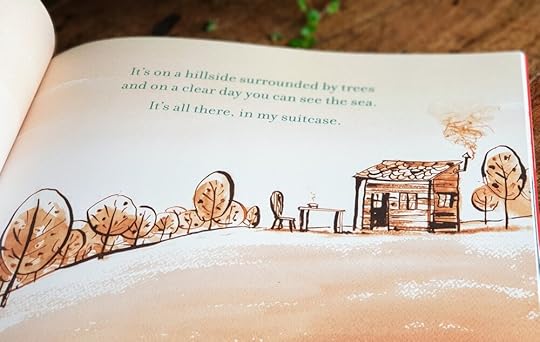
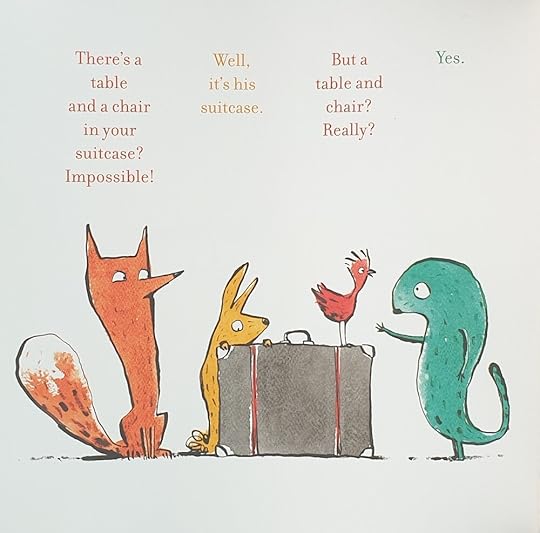
The Suitcase by Chris Naylor-Ballesteros (Nosy Crow, 2019) | © 2019 by Chris Naylor-Ballesteros
I love this idea! It’s so intriguing. And like the animals, I was desperate to see for myself the contents of that case. How could it possibly contain so much? Before any more questions can be asked, the stranger excuses himself:
… I’m sorry, I’m really very, very tired. I’ve been travelling for a long time and come a long way. I must have a little rest…
“Well, I don’t trust him,” says the fox. “How do we know he’s telling the truth?”
“We slip so easily into being tribal, into being suspicious of people who seem different to us,” writes Miranda McKearney of Empathy Lab. “The Suitcase gently and powerfully explores the transformation that comes when we manage to open our minds and hearts.”
Unfortunately, before the animals let that happen, they need to see inside the suitcase…
When I first read The Suitcase, I was shocked by what happens next, and the way that the animals’ curiosity and suspicion are played out:
“Someone pass me a big rock. We’re going to break open the suitcase and see what’s inside.”
“Maybe we should. We need to know the truth.”
“You can’t do that. It’s not ours!”
In no time at all, the suitcase was open.
“See? A broken teacup and an old photograph. He lied to us!”“Well, no… h-he did say there was a teacup.”
“Yes. And now his suitcase is broken too! What will he think of us?”
Meanwhile, the exhausted stranger sleeps, dreaming of swimming across deep (and threatening-looking) waters with his suitcase.
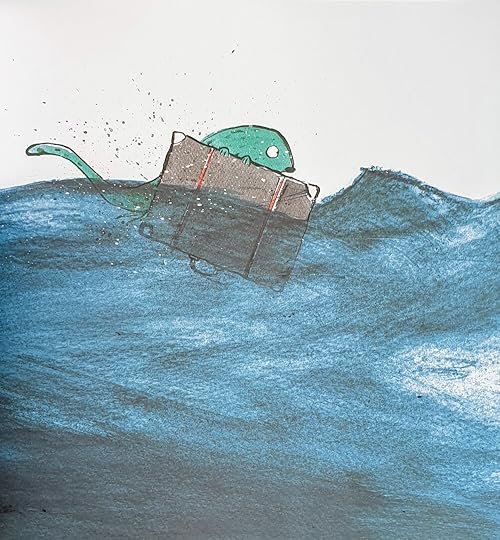
The Suitcase by Chris Naylor-Ballesteros (Nosy Crow, 2019) | © 2019 by Chris Naylor-Ballesteros
I’m loathed to reveal what happens when he wakes up - so I shan’t. Suffice to say the animals recognise their bad behaviour. They make amends, and we leave the stranger with a smile on his face. New friendships are forming. The future is bright and hopeful.
But despite the implied happily-ever-after, I found the ending is bittersweet.
Why?
Because this book touched me, reminding me, albeit in a simplistic way, the desperate plight that so many people face each day.
And that’s its power: It is challenging and thought-provoking.
“I didn’t set out to write a story explicitly about a refugee,” says the book’s creator, Naylor-Ballesteros, “but it is obviously open to that interpretation. I also like to think it could apply to any unexpected arrival that needs help and acceptance but might disturb established relationships and situations: the child that suddenly arrives out of nowhere at your school in the middle of term, the new family in your street who are apprehensive and shy. And, of course, the person who is fleeing poverty or war and has taken a huge risk to find stability and shelter. I hoped my stranger could be seen as any of these things.”
I love that quote. It reminds me of another unexpected arrival who needed help and acceptance and disturbed suburbia: Paddington! (Until I discovered a postcard of this image in Bristol, I’d never thought of him as a refugee.)
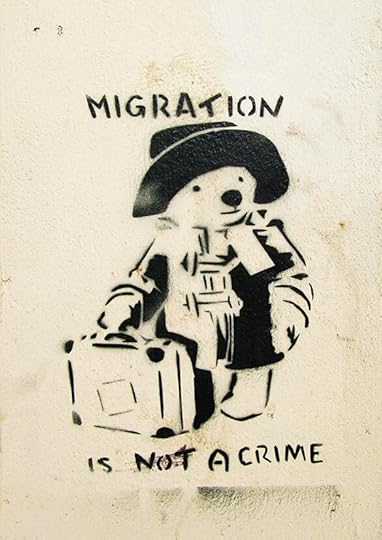
Source: Exquisite Artz
That image continues to strike a chord with me. Similarly, I think (and hope) that The Suitcase will enable us to shift our perspective. That it will challenge us to regard refugees with compassion - and as people that want (and need) to be seen and heard.
Here’s why The Suitcase is Good to Read
It’s an excellent way to start conversations with your kids about kindness and how we respond to strangers.
(Which, in turn, will develop empathy.)
The more children flex their empathy muscle, the more thoughtful they will become.
It introduces the concept of looking at a situation from different perspectives.
And here are some questions you might ask around the story:
How does the stranger feel?
Why did he make such a dangerous journey?
Why is Fox suspicious?
How would you feel if someone broke into your suitcase?
What’s with the broken teacup?
Discover more about Chris Naylor-Ballesteros’s work hereGood to readBooks for Developing EmpathyHug by Jez Alborough (Walker 2000)
King of the Sky by Nicola Davies, illustrated by Laura Carlin (Walker Books 2017)
A Little Bit Worried by Ciara Gavin, ill. by Tim Warnes (Little Tiger Press 2020)
The Colour Monster by Anna Llenas (Templar 2012)
DANGEROUS! by Tim Warnes (Little Tiger Press 2014)
My Friend is Sad by Mo Willems (Walker 2007)
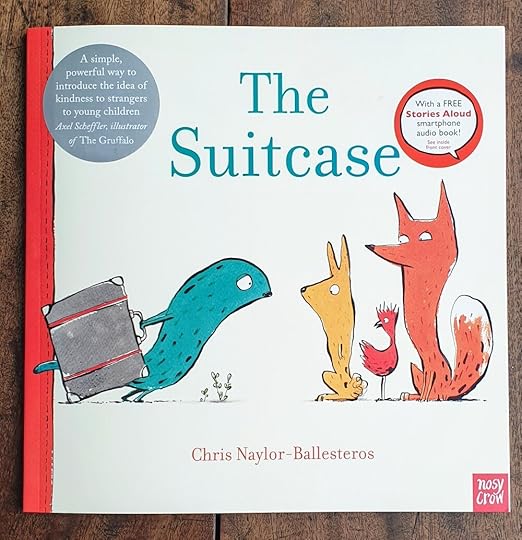
The Suitcase by Chris Naylor-Ballesteros (Nosy Crow, 2019) | © 2019 by Chris Naylor-Ballesteros
"Welcome and understanding are at the heart of this children’s book by Chris Naylor-Ballesteros. . . beautifully illustrated."
- Laura Padoan, spokesperson for UNHCR, the UN Refugee AgencyBuy US
Buy UK
SourcesJesus quoted from Matthew 25:35 (Amplified Bible) The Suitcase by Chris Naylor-Ballesteros (Nosy Crow 2019)The Suitcase: Review (Carnegiegreenaway.org.uk)The Suitcase: Review (Lovereading4kids.couk)Unpacking The Suitcase – a guest post by Chris Naylor-Ballesteros (nosycrow.com)Street Art Paddington: Exquisite Artz © 2020 BY TIM WARNES (UNLESS OTHERWISE ATTRIBUTED)****USE OF THIRD PARTY COPYRIGHTED MATERIAL FALLS UNDER FAIR USE/FAIR DEALING PRACTICE.
My Life in Books
For lovers of kid lit, this memoir - My Life in Books - is intended to give you the confidence and encouragement to share your own passion; to help you make lasting connections through kids’ books.
Originally posted at www.timwarnes.com ...more
- Tim Warnes's profile
- 30 followers



